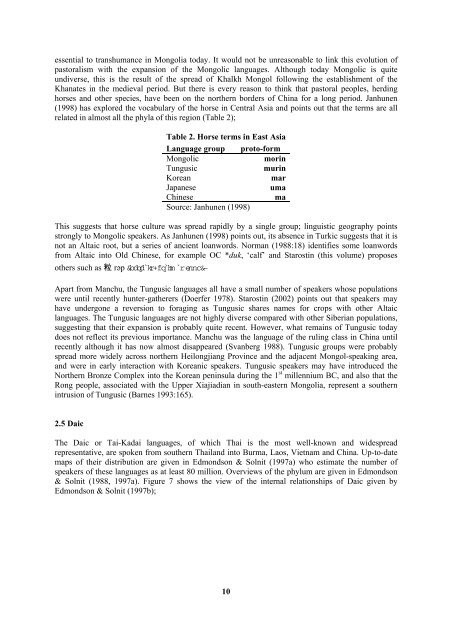Geneva paper 2004 submit.pdf - Roger Blench
Geneva paper 2004 submit.pdf - Roger Blench
Geneva paper 2004 submit.pdf - Roger Blench
Create successful ePaper yourself
Turn your PDF publications into a flip-book with our unique Google optimized e-Paper software.
essential to transhumance in Mongolia today. It would not be unreasonable to link this evolution of<br />
pastoralism with the expansion of the Mongolic languages. Although today Mongolic is quite<br />
undiverse, this is the result of the spread of Khalkh Mongol following the establishment of the<br />
Khanates in the medieval period. But there is every reason to think that pastoral peoples, herding<br />
horses and other species, have been on the northern borders of China for a long period. Janhunen<br />
(1998) has explored the vocabulary of the horse in Central Asia and points out that the terms are all<br />
related in almost all the phyla of this region (Table 2);<br />
Table 2. Horse terms in East Asia<br />
Language group proto-form<br />
Mongolic<br />
morin<br />
Tungusic<br />
murin<br />
Korean<br />
mar<br />
Japanese<br />
uma<br />
Chinese<br />
ma<br />
Source: Janhunen (1998)<br />
This suggests that horse culture was spread rapidly by a single group; linguistic geography points<br />
strongly to Mongolic speakers. As Janhunen (1998) points out, its absence in Turkic suggests that it is<br />
not an Altaic root, but a series of ancient loanwords. Norman (1988:18) identifies some loanwords<br />
from Altaic into Old Chinese, for example OC *duk, ‘calf’ and Starostin (this volume) proposes<br />
others such as 粒 rəp 'cereals,grain as food'.<br />
Apart from Manchu, the Tungusic languages all have a small number of speakers whose populations<br />
were until recently hunter-gatherers (Doerfer 1978). Starostin (2002) points out that speakers may<br />
have undergone a reversion to foraging as Tungusic shares names for crops with other Altaic<br />
languages. The Tungusic languages are not highly diverse compared with other Siberian populations,<br />
suggesting that their expansion is probably quite recent. However, what remains of Tungusic today<br />
does not reflect its previous importance. Manchu was the language of the ruling class in China until<br />
recently although it has now almost disappeared (Svanberg 1988). Tungusic groups were probably<br />
spread more widely across northern Heilongjiang Province and the adjacent Mongol-speaking area,<br />
and were in early interaction with Koreanic speakers. Tungusic speakers may have introduced the<br />
Northern Bronze Complex into the Korean peninsula during the 1 st millennium BC, and also that the<br />
Rong people, associated with the Upper Xiajiadian in south-eastern Mongolia, represent a southern<br />
intrusion of Tungusic (Barnes 1993:165).<br />
2.5 Daic<br />
The Daic or Tai-Kadai languages, of which Thai is the most well-known and widespread<br />
representative, are spoken from southern Thailand into Burma, Laos, Vietnam and China. Up-to-date<br />
maps of their distribution are given in Edmondson & Solnit (1997a) who estimate the number of<br />
speakers of these languages as at least 80 million. Overviews of the phylum are given in Edmondson<br />
& Solnit (1988, 1997a). Figure 7 shows the view of the internal relationships of Daic given by<br />
Edmondson & Solnit (1997b);<br />
10
















